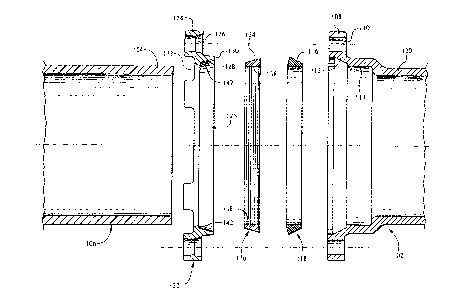Une partie des informations de ce site Web a été fournie par des sources externes. Le gouvernement du Canada n'assume aucune responsabilité concernant la précision, l'actualité ou la fiabilité des informations fournies par les sources externes. Les utilisateurs qui désirent employer cette information devraient consulter directement la source des informations. Le contenu fourni par les sources externes n'est pas assujetti aux exigences sur les langues officielles, la protection des renseignements personnels et l'accessibilité.
L'apparition de différences dans le texte et l'image des Revendications et de l'Abrégé dépend du moment auquel le document est publié. Les textes des Revendications et de l'Abrégé sont affichés :
| (12) Brevet: | (11) CA 2130777 |
|---|---|
| (54) Titre français: | JOINT MECANIQUE DE TUYAU |
| (54) Titre anglais: | MECHANICAL PIPE JOINT |
| Statut: | Durée expirée - au-delà du délai suivant l'octroi |
| (51) Classification internationale des brevets (CIB): |
|
|---|---|
| (72) Inventeurs : |
|
| (73) Titulaires : |
|
| (71) Demandeurs : |
|
| (74) Agent: | KIRBY EADES GALE BAKER |
| (74) Co-agent: | |
| (45) Délivré: | 1998-09-22 |
| (22) Date de dépôt: | 1994-08-24 |
| (41) Mise à la disponibilité du public: | 1995-05-17 |
| Requête d'examen: | 1995-11-30 |
| Licence disponible: | S.O. |
| Cédé au domaine public: | S.O. |
| (25) Langue des documents déposés: | Anglais |
| Traité de coopération en matière de brevets (PCT): | Non |
|---|
| (30) Données de priorité de la demande: | ||||||
|---|---|---|---|---|---|---|
|
Cette invention concerne un joint mécanique amélioré pour l'assemblage de tuyaux à emboîtement ordinaires. Le joint comprend un fouloir dans la cavité conique de laquelle se loge une bague fendue crénelée qui comprime radialement le bout uni du tuyau et s'y accroche à mesure le fouloir est serré contre le bout évasé du tuyau adjacent. L'étanchéité est réalisée par un joint compressible placé entre la bague fendue et le bout évasé. Le fouloir comprend en outre un épaulement radiale qui s'appuie contre la bague fendue et empêche le fouloir de la dépasser à l'assemblage.
An improved mechanical pipe joint for use in a bell
and plain pipe end assembly. The joint includes a gland
having a conical cavity for receiving a toothed split ring
that coaxially compresses and grips the plain pipe end as
the gland is tightened to the bell. The joint is sealed by
a compressible gasket positioned between the split ring and
the bell. The gland further includes an integrally formed,
radially extending shelf for abutting against the split
ring and mechanically stopping the gland from being pulled
over the split ring during joint assembly.
Note : Les revendications sont présentées dans la langue officielle dans laquelle elles ont été soumises.
Note : Les descriptions sont présentées dans la langue officielle dans laquelle elles ont été soumises.

2024-08-01 : Dans le cadre de la transition vers les Brevets de nouvelle génération (BNG), la base de données sur les brevets canadiens (BDBC) contient désormais un Historique d'événement plus détaillé, qui reproduit le Journal des événements de notre nouvelle solution interne.
Veuillez noter que les événements débutant par « Inactive : » se réfèrent à des événements qui ne sont plus utilisés dans notre nouvelle solution interne.
Pour une meilleure compréhension de l'état de la demande ou brevet qui figure sur cette page, la rubrique Mise en garde , et les descriptions de Brevet , Historique d'événement , Taxes périodiques et Historique des paiements devraient être consultées.
| Description | Date |
|---|---|
| Inactive : Périmé (brevet - nouvelle loi) | 2014-08-24 |
| Inactive : CIB de MCD | 2006-03-11 |
| Inactive : CIB de MCD | 2006-03-11 |
| Inactive : TME en retard traitée | 2005-09-01 |
| Lettre envoyée | 2005-08-24 |
| Lettre envoyée | 2004-12-01 |
| Lettre envoyée | 2001-09-07 |
| Accordé par délivrance | 1998-09-22 |
| Préoctroi | 1998-04-14 |
| Inactive : Taxe finale reçue | 1998-04-14 |
| Lettre envoyée | 1997-10-15 |
| Un avis d'acceptation est envoyé | 1997-10-15 |
| Un avis d'acceptation est envoyé | 1997-10-15 |
| Inactive : Renseign. sur l'état - Complets dès date d'ent. journ. | 1997-10-09 |
| Inactive : Dem. traitée sur TS dès date d'ent. journal | 1997-10-09 |
| Inactive : CIB enlevée | 1997-08-22 |
| Inactive : CIB en 1re position | 1997-08-22 |
| Inactive : CIB attribuée | 1997-08-22 |
| Inactive : Approuvée aux fins d'acceptation (AFA) | 1997-08-13 |
| Toutes les exigences pour l'examen - jugée conforme | 1995-11-30 |
| Exigences pour une requête d'examen - jugée conforme | 1995-11-30 |
| Demande publiée (accessible au public) | 1995-05-17 |
Il n'y a pas d'historique d'abandonnement
Le dernier paiement a été reçu le 1998-08-17
Avis : Si le paiement en totalité n'a pas été reçu au plus tard à la date indiquée, une taxe supplémentaire peut être imposée, soit une des taxes suivantes :
Les taxes sur les brevets sont ajustées au 1er janvier de chaque année. Les montants ci-dessus sont les montants actuels s'ils sont reçus au plus tard le 31 décembre de l'année en cours.
Veuillez vous référer à la page web des
taxes sur les brevets
de l'OPIC pour voir tous les montants actuels des taxes.
Les titulaires actuels et antérieures au dossier sont affichés en ordre alphabétique.
| Titulaires actuels au dossier |
|---|
| TYLER PIPE INDUSTRIES |
| Titulaires antérieures au dossier |
|---|
| MINOR W. PANNELL |
| OLIN I. JACKSON |
| THOMAS D. HUNTER |